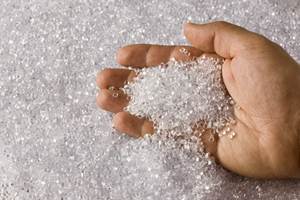Uncertainty in Foil Market Spurs Metallized OPP & PET Growth
Toray’s advanced barrier-durable metallized films are designed for foil-replacement applications.
We recently heard from Toray Plastics America, North Kingstown, R.I., that the company is offering industry assurance that its proven, barrier-durable, cost-effective MET OPP and MET PET films—including several with advanced integrated sealant technology, are readily available to replace foil.
There is uncertainty about the availability and price of aluminum foils used for packaging applications in response to the antidumping duty (AD) and countervailing duty (CVD) investigations led by the U.S. Department of Commerce. This has prompted CPG (consumer packaged goods) companies and converters to consider alternative substrates and creative solutions for their packaging needs.
Toray extruded and orients its OPP and PET films, which include bio-based versions, and has the capability to metallize and coat many of them, including “dialing in” barrier and unique seal-strength characteristics for customized applications. The company boasts vertical manufacturing, which ensures product quality control and provides customers with convenient, cost-effective bundling, ordering, and shipping.
According to Tammy Williamson, associate product manager of the Torayfan Polypropylene Film Division, Fortune 100 companies, medium and small regional manufacturers, and converters have relied on Toray’s advanced metallized OPP and PET film technology for over 30 years to protect product freshness and build brand loyalty. Specifically addressing the company’s metallized film for foil-replacement, Williamson notes that several “forward-thinking customers” were early adopters of MET OPP as a drop-in replacement in paper-PE-foil-PE (PPFP) packet and SUP packaging used for oatmeal, hot cocoa, seasonings, dried soup, rice, dried cheese, mixes, powdered beverages, and nutrition/energy drinks.
“They discovered that Toray’s advanced film technology could equal or surpass the moisture- and oxygen-barrier durability, yield and economics of traditional foil, while also helping to manufacture an attractive, resilient finished package.”
Toray Plastics (America), Inc.’s Torayfan PC1, PC3, PC5 and M23 OPP films are designed specifically for drop-in foil-replacement and buried-barrier web applications. They reportedly offer excellent flex-crack and puncture resistance and deliver excellent moisture- and oxygen-barrier durability. Grades PCFS, MH5C, and LGHX5 metallized films for PPFP applications have the additional feature of integrated sealant technology, allowing for the replacement of the foil and sealant layer.
Williamson adds that pouches for coffee, nuts, dried fruits, and salty snacks that are made with foil are also ideally suited for foil-replacement. Toray’s Lumirror MK61 and MK6HB MET PET films are robust alternatives to foil that offer outstanding oxygen- and moisture-barrier protection for those foods. They may be used as an outer layer in a two-ply lamination or as the middle layer in a three-ply lamination.
Toray boasts that its MET OPP and MET PET have industry-leading adhesion and greater bond strength between the non-metal lamination layer and extrusion laminations/coatings when compared with regular corona-treated films. These characteristics reportedly eliminate the dissatisfying delaminated “pouch-in-a-pouch” effect that can occur when a consumer opens a weaker package. Toray also claims that its foil-replacement films are the thinnest available in the packaging industry delivering more film per pound than do thicker films and making them a smart, sustainable option, yet they maintain strong package-processing characteristics. Increased footage also enables converters to lower the number of required roll changes, thus reducing the amount of scrap and providing even greater cost savings and another sustainability advantage.
The company also believes that marketers prefer the physical properties of its MET OPP and MET PET films because unlike foil, these films do not exhibit a “shop worn” appearance after packaging and handling. Packets makes a positive impression when taken out of the box, and stand-up pouches maintain a fresh, eye-catching appearance on the retail shelf.
Related Content
Formulating LLDPE/LDPE Blends For Abuse–Resistant Blown Film
A new study shows how the type and amount of LDPE in blends with LLDPE affect the processing and strength/toughness properties of blown film. Data are shown for both LDPE-rich and LLDPE-rich blends.
Read MoreNew Entrant Heartland Polymers Stepping up as Reliable Supplier
Heartland Polymers’ new Alberta, Canada facility will produce 525 KTA propylene and 525 KTA polypropylene. It is expected to stabilize supply chains across the continent.
Read MorePrices Up for PE, PP, PS, Flat for PVC, PET
Trajectory is generally flat-to-down for all commodity resins.
Read MoreThe Fundamentals of Polyethylene – Part 1: The Basics
You would think we’d know all there is to know about a material that was commercialized 80 years ago. Not so for polyethylene. Let’s start by brushing up on the basics.
Read MoreRead Next
Understanding Melting in Single-Screw Extruders
You can better visualize the melting process by “flipping” the observation point so that the barrel appears to be turning clockwise around a stationary screw.
Read MorePeople 4.0 – How to Get Buy-In from Your Staff for Industry 4.0 Systems
Implementing a production monitoring system as the foundation of a ‘smart factory’ is about integrating people with new technology as much as it is about integrating machines and computers. Here are tips from a company that has gone through the process.
Read MoreHow Polymer Melts in Single-Screw Extruders
Understanding how polymer melts in a single-screw extruder could help you optimize your screw design to eliminate defect-causing solid polymer fragments.
Read More


























